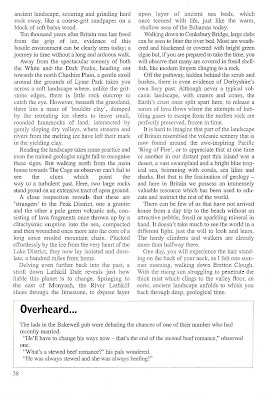 |
| A view of Bretton Clough emerging from the early morning mist |
After a break of 16 months due to the COVID-19 Pandemic, the Sheffield U3A Geology Group finally reconvened for their monthly field trip, this time to visit Bretton Clough in the Peak District National Park – a place that I had last seen in August 1995.
Living in Bakewell at the time, through my involvement with the South Yorkshire RIGS Group, I was commissioned by the Derbyshire Wildlife Trust to undertake a survey of the Regionally Important Geological Sites (RIGS) – to identify places that would take pressure off tourist honeypots such as Castleton and the Roaches and which would be of interest to groups such as ours.
As required, when there was no general public access to the land that I had to survey, I phoned the landowner to obtain permission and, during a good talk, he was adamant that the principal landforms seen in Bretton Clough were not the result of landslides.
In the days before the Internet and without access to the publications available to university academics etc, I only had my British Geological Survey Sheet 99 Map and its accompanying memoir to guide me – which only briefly mentions the landslips in a few lines.
Setting off early from Bakewell on a Saturday morning in August, I parked at the road on Hucklow Edge where the public footpath leads to Abney Grange and, when arriving at the edge of Bretton Clough, the deep valley was covered in thick mist.
This soon burned off to reveal a series of very well defined symmetrical ridges that run along the length of the western end of the valley, with no signs of slumping or disruption of the strata here. My immediate thought was that these landforms were not slide blocks, but in situ remnants of the bedrock that have left behind after the very rapid erosion of the valley by glacial meltwater.
Before and since, I have seen landslips at Mam Tor, Back Tor, Canyards Hills, Longdendale, Higger Tor and Bent Hills and to the north facing side of the valley, scars in the rock face and large areas of very uneven and irregularly formed masses of bracken covered ground seen at Bretton Clough are similar to all of these and are obviously landslips.
Descending into the valley, I subsequently explored several of the ridges and although I did not take any measurements with a compass-clinometer, I could see several sections through the turbidite sandstones and shales, which to my eye were undisturbed and had a dip that was consistent with the 5 degrees dip to the north-east marked on the British Geological Survey map.
I don’t pretend to be an expert in geomorphology but, on this occasion, when I caught my first glimpse of the landscape emerging from the mist, I felt the hair stand up on the back of my neck and was convinced that both myself and the landowner were absolutely right.









No comments:
Post a Comment